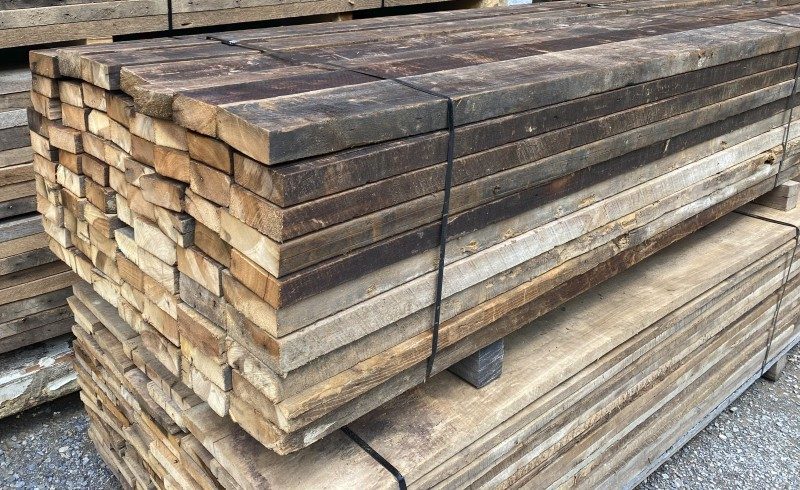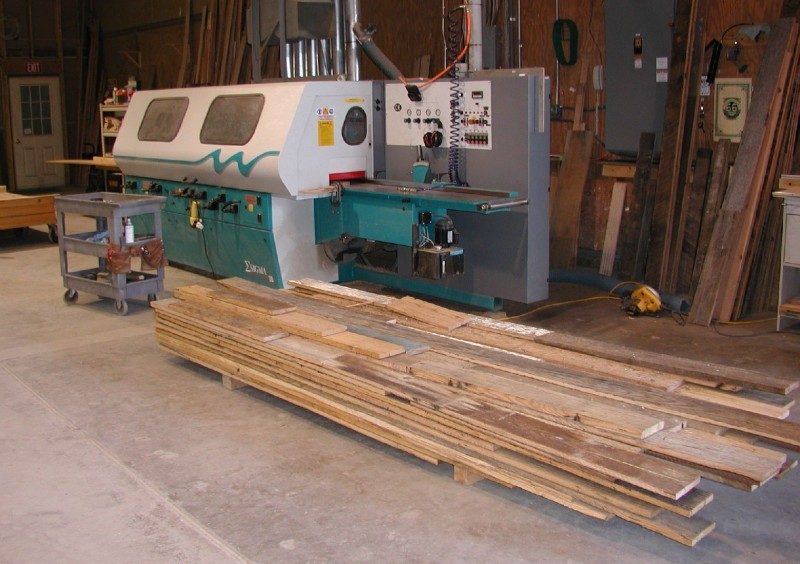Antique Barn Board Oak
The first step in the process of delivering beautiful recycled wood floors to customers is procuring the raw materials. Every flooring board served at one time as part of a building that provided shelter for crops and livestock in the eastern United States. Oak was a plentiful wood during westward expansion and was used when those in agriculture wanted a lasting building to suit their needs. You may ask why these buildings are not serving their purpose any more. The answer is that many of these buildings have not been used for their original purposes for years and have fallen into disrepair. What is not suitable for a farm structure, however, still has plenty of usable, cured raw materials in boards and beams.

Usually a landowner will make the first contact to let us know that there is a structure that is suitable. Once the structure is deemed usable for the materials, the next step is taking the building down in a safe manner that will yield good usable lumber. Often this is done by Appalachian Woods or by an individual that sells the material to us. Once the material is on site at our lumber yard, the boards or beams are measured and are added to the raw material inventory of the company. This is the first rough quality control checkpoint, and only the best material is used by Appalachian Woods. What was only days or weeks before a structure with no practical use is now ready to be processed into some of the most unique and beautiful flooring in the country.

Now that raw materials have been procured and are on our lumber yard, the careful processing of this wood begins. The main steps in the process are metal detection, grading, edging, sticking and drying. Because this wood was used in construction previously much of the wood still has “hardware” in it. All hardware must be removed to protect woodworking machinery and to ensure that a homeowner never encounters any metal in their floors. First the de-nailer will remove all visible metal. Next they use a sensitive metal detector to find any nails that were broken off or are not easily identified by sight. If any nails are found they are removed with hammers, chisels, and pliers. In most cases this can all be done with minimal damage to the original surface of the wood. All recycled wood has to go through several quality control check points before it is shipped out to the home-owner. The first round of grading takes place during the metal detecting process. Any boards or sections of boards that are not suitable are removed, and only solid usable lumber is edged to size and dried. The removal of this material saves time in processing and helps keep down costs to the end user. The wood is now suitable to be moved into the next part of the process. Often times material comes into the lumber yard with imperfect edges or in irregular widths. Using a saw (edger) to trim off these rough edges makes the rest of the manufacturing process more efficient and ensures that all flooring has usable full tongues and grooves. Flooring is generally graded again as it is sticked. Sticking entails placing long narrow pieces of wood crossways between each layer of recycled lumber. This allows for air to pass through and for wood to be dried. At this point the wood is placed in a kiln to be dried to a point that meets industry standards for flooring. All of the wood is still rough at this point, but it could now be used in construction and for the most rustic of applications. The sticks are now removed and the lumber is stacked tight to save space in storage and transportation to the next manufacturing location. Lumber at this point is only a few short days from final shipment to a building site. Making these first steps as efficient as possible saves the company money which is then passed on to the end user. The next steps turn rough lumber into easy to install beautiful recycled flooring.

Recycled lumber has been procured, metal detected, edged, sticked, and dried, but there are still three important steps that must be taken to ensure that the finest flooring is delivered to the job site. Lumber must be milled into flooring, graded and end trimmed, and packaged for delivery. A six head molder is used to turn rough lumber into tongue and grooved flooring. Four heads plane top and bottom surfaces to a smooth usable face and back, while two heads cut the tongues and grooves to ensure that every piece of flooring fits tightly together and stays in place. Now that fresh surfaces are visible the final quality control grading can take place. End trimming ensures that ends of flooring boards will fit tight together, and also gives the final opportunity to cut out any defects that were not visible previously. What is left after this step should be 100% usable flooring that matches products descriptions given by the company. Each order is a custom order with recycled wood so only enough to fill an order is processed. After the flooring is graded and measured it must be packaged for shipping. Custom pallets are built in house because each shipment is unique. Sturdy cardboard, metal strapping, and plastic shrink wrap ensure that the flooring is as beautiful when it arrives at the job site as it was when it left the manufacturing facility. It may be obvious at this point that creating antique oak flooring is a time consuming process. This is true, but the whole process of recycling is also very rewarding for those involved in the process. Turning a historical treasure into a one of a kind floor that has hundreds of years of character (from tree to barn to floor) is a labor of love. Ask anyone who is a part of this process what their dream floor is and they will tell you it is the same kind they help make every day!
Gabriel Hochstetler
Appalachian Woods, LLC


